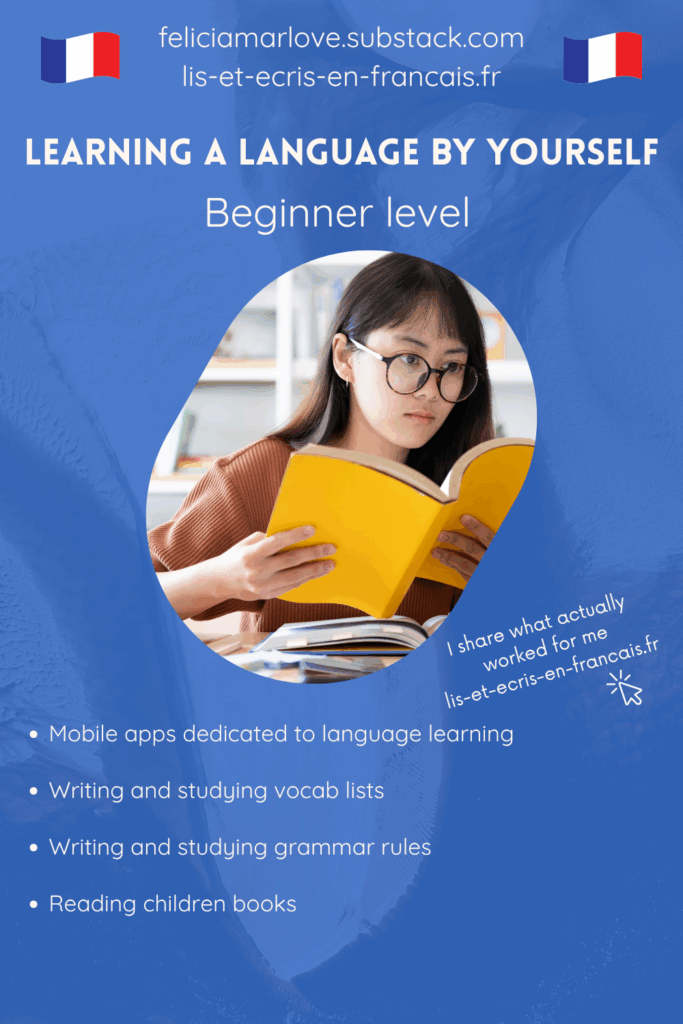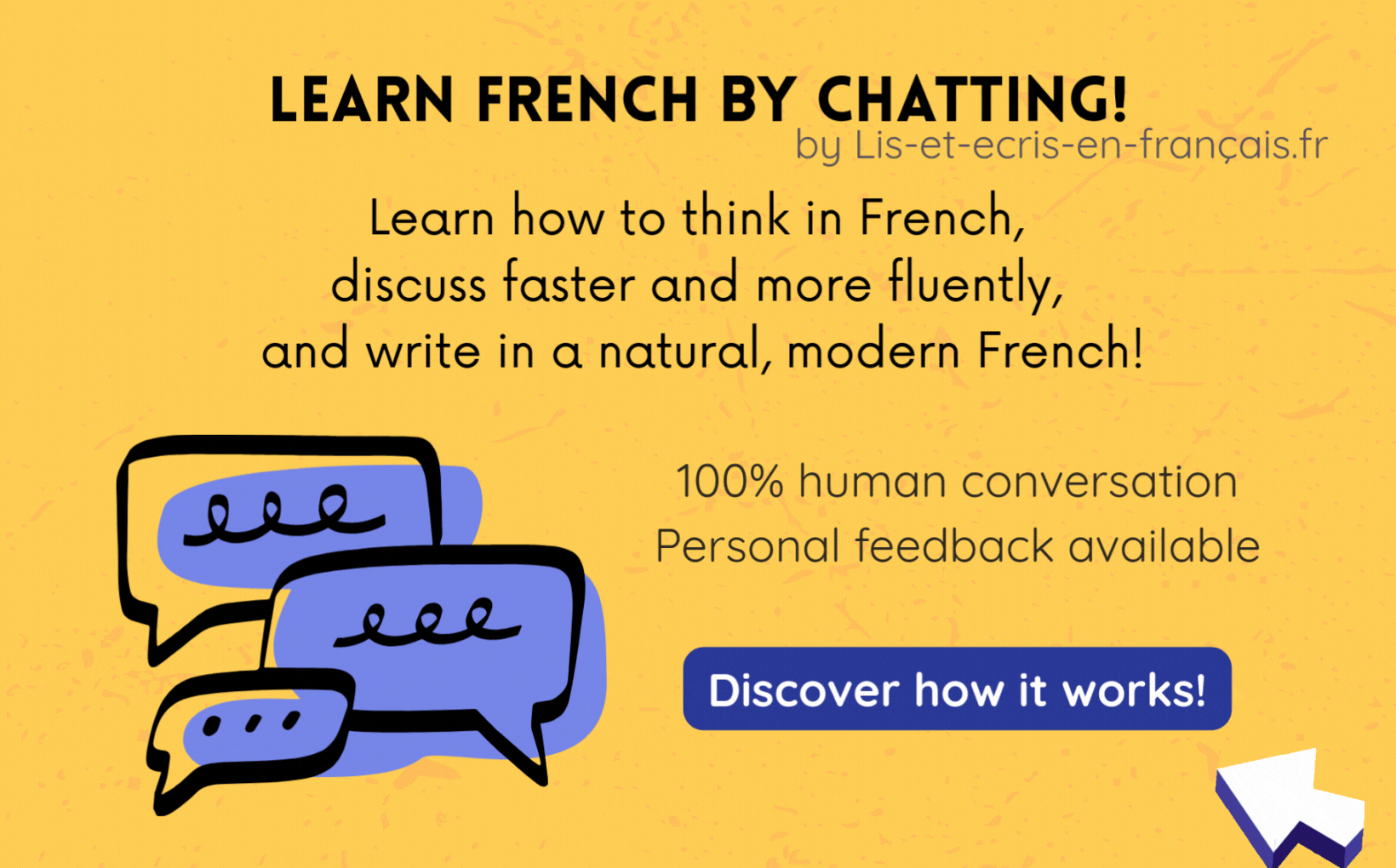On this blog, I publish texts and advice for French learners. I had this idea because I do love learning foreign languages myself. For a few years now, I’ve been learning one all by myself.
I’ve tried several methods to learn that new language on my own. In this post, I share everything I tried when I was a beginner, what worked well and what didn’t do so well. You’ll notice that my favorite methods are in line with the concepts of “comprehensible input” and inspire me in my way of “teaching” natural French.
There will be several articles in this series because I’ve tried, and am still trying, a lot of methods to improve my language learning. These posts will cover different stages of my evolution. This part is about the very first things I tried.
Hey, did you know all of my articles are available in French original version? If you’re learning French with the “language acquisition” or “comprehensible input” methods, I strongly encourage you to try to read the native French version first. Please note the English version is not a literal translation.
Mobile apps to learn languages
The one app I used a lot was DuoLingo, to the point I once reached a 1.000 days streak! Thanks to that app, I learned the basics of the language, like alphabet or sentence construction and I memorized a few words.
However, I’ve always used DuoLingo in combination with other learning materials : I was also reading articles or watching videos about the language, and using a textbook. Without those sides, I would have memorized thinks that are not totally correct, and totally not natural.
In addition, with DuoLingo, I was limited to the topics available in the app. Those were not always interesting for me, but I had no choice but to keep on passing the levels to reach the next topics.
For quite some time, I felt like DuoLingo was really making me progress, but one day I realized I should have a much better level after I spent so many hours on this app !
I’ve also occasionally used other apps, like Drops, to learn vocabulary, and some others to learn vocabulary or play crosswords.
How I feel about apps
These allowed me to start learning in a fun way and gave me the basics, but I’ve got to admit they’re not enough. If I decide to learn another language in the future, I would spent way less time on them and would switch to efficient methods more quickly.
I think those apps give you the impression that you’re progressing, while you’re actually just checking steps, or literally passing levels or getting more points. Another bad point is that your learning journey is not tailored at all, you can end up learning a bunch of generic stuff that don’t fit your purpose.
Writing and studying vocabulary lists
I was writing words in a note book, just as I was in school years ago: drawing a column, writing a word on the left and its translation in my mother tongue on the right. At first, I was regularly studying. After a few months, then a few years of learning, there were too many pages to study.
It wasn’t really motivating either. At first, I was all fired up and really regular, but it faded really fast. To be honest, memorizing vocab lists is boring!
Later, I changed my technic and started writing full sentences. I think it’s more efficient… but I still don’t read them really often.
How I feel about vocabulary lists
I think one should move on to other technics, including writing full sentences, as soon as possible. Memorizing those vocab lists is only useful to pass exams. To practice reading, writing and speaking, it’s better to understand words in a context.
Writing down and studying grammar rules🌟
Some people say it’s not necessary to study grammar to start practicing a new language. I personally think it’s better to do so, although I agree you shouldn’t try to learn the whole grammar first thing.
After getting the basics, I’m now interested in grammar rules when I meet them in a text or in an audio content. I make my research case by case.
I think it’s still important to have a look at the grammar and take it into account, as you could develop bad habits by neglecting them. It might be more difficult to unlearn them after a while.
Here’s why I copy grammar rules instead of using a grammar book:
- I can write only what I actually need right now. It’s easier if I want to review the theory at some point.
- I can organize it in a way that works for me.
- I can compile information from different sources to create the most complete summary, and have all the information in one place.*
- I can write many example sentences that are easy to understand for me and demonstrate the concept.
*For example, I find a lot of additional nuances and information in content created by native speakers. Grammar books are not enough and sometimes don’t actually reflect the reality of the language.
How I feel about writing grammar rules
That’s something I would definitely do again, and that I keep on doing, although I try to write example sentences more than extended rules. This grammar book of mine shows the information in the most efficient way for me and I can use it as a reference when I practice comprehensible input.

Reading children books
I tried reading children books really soon in the process, but I didn’t find it as easy as foreseen. The language used in those books is not really natural, and the topics are rarely interesting for adults.
I faced an additional burden, as I’m learning Japanese and it has several alphabets. Children books are written in a different alphabet than everyday content, which in turn made the reading more complicated.
How I feel about reading children books to learn a new language
I think’s it’s not motivating for an adult to read those stories. Also, story books often use a style that is not natural at all, so it’s barely useful to learn the language. And the topics are not the most interesting ones either. I would advise to look for content that is meant for adults or teenagers at least, but that is also accessible, either content made specifically for “comprehensible input”, or lighter contents (like comics or manga for example).
Here are some resources dedicated to French comprehensible input, as well as French native content.
Haven’t read the original French version yet? Start practising reading in French with the French-only version and learn some new expressions.
Read part 2: Learning a language by myself, from beginner to intermediate
